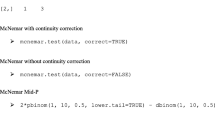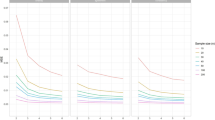Abstract
Meta-analysis provides an integrated analysis and summary of the effects observed in \(k\) independent studies. The conventional analysis proceeds by first calculating a study-specific effect estimate, and then provides further analysis on the basis of the available \(k\) independent effect estimates associated with their uncertainty measures. Here we consider a setting where counts of events are available from \(k\) independent studies for a treatment and a control group. We suggest to model this situation with a study-specific Poisson regression model, and allow the study-specific parameters of the Poisson model to arise from a nonparametric mixture model. This approach then allows the estimation of the heterogeneity variance of the effect measure of interest in a nonparametric manner. A case study is used to illustrate the methodology throughout the paper.

Similar content being viewed by others
REFERENCES
M. Borenstein, L. V. Hedges, J. P. T. Higgins, and H. R. Rothstein, Introduction to Meta-Analysis (Wiley, Chichester, 2009).
D. Böhning, Computer-Assisted Analysis of Mixtures and Applications. Meta-Analysis, Disease Mapping and Others (Chapman and Hall, CRC, Boca Raton, 2000).
D. Böhning, K. Mylona, and A. Kimber, ‘‘Meta-analysis of clinical trials with rare events,’’ Biometr. J. 57, 633–648 (2015).
N. J. Cooper, K. R. Abrams, A. J. Sutton, D. Turner, and P. C. Lambert, ‘‘Use of bayesian methods for Markov modelling in cost-effectiveness analysis: An application to taxane use in advanced breast cancer,’’ J. R. Stat. Soc., Ser. A 166, 389–405 (2003).
A. P. Dempster, N. M. Laird, and D. B. Rubin, ‘‘Maximum likelihood from incomplete data via the EM algorithm,’’ J. R. Stat. Soc., Ser. B 39, 1–38 (1977)
J. P. T. Higgins and S. G. Thompson, ‘‘Quantifying heterogeneity in a meta-analysis,’’ Stat. Med. 21, 1530–1558 (2002).
B. G. Lindsay, ‘‘The geometry of mixture likelihoods: A general theory,’’ Ann. Stat. 11, 86–94 (1983).
B. G. Lindsay, ‘‘Mixture models: Theory, geometry and applications,’’ in NSF-CBMS Regional Conference Series in Probability and Statistics (Inst. Math. Stat., Hayward, 1995).
G. J. McLachlan and T. Krishnan, The EM Algorithm and Extensions (Wiley, New Jersey, 2007).
P. A. Naik, P. Shi, and C. L. Tsai, ‘‘Extending the Akaike information criterion to mixture regression models,’’ J. Am. Stat. Assoc. 102, 244–254 (2007).
S. Ray and B. G. Lindsay, ‘‘Model selection in high dimensions: A quadratic-risk-based approach,’’ J. R. Stat. Soc., Ser. B 70, 95–118 (2008).
R. Schulze, H. Holling, and D. Böhning, Meta-Analysis: New Developments and Applications in Medical and Social Sciences (Hogrefe and Huber, Göttingen, 2003).
F. Smaill and G. J. Hofmeyr, ‘‘Antibiotic prophylaxis for cesarean section,’’ Cochrane Database Syst. Rev. 3, 1–71 (2002).
Stata Statistical Software: Release 116 (StataCorp LLC, College Station, TX, 2019).
Author information
Authors and Affiliations
Corresponding authors
Additional information
(Submitted by A. I. Volodin)
APPENDIX
APPENDIX
STATA CODE
All computations were done using the package STATA16 (StataCorp 2019). In the following we demonstrate how to fit a two-component, bivariate mixture model. Different numbers of components can be achieved by replacing 2 with any desired number of components. The log-relative risks for the components are \({-}0.1581758\) and \({-}0.743582\). The associated weights can be found using the command estat lcprob which is provided at the end of the output below. \(y\) are the counts of events and \(\log n\) is the log-size of the study. \(treat\) is a binary treatment indicator with 1 denoting being in the treatment group and 0 otherwise.
. fmm 2 : poisson y treat, exposure(logn)
Finite mixture model Number of obs = 122
Log likelihood = -307.22036
Class : 1
Response : y
Model : poisson
Coef. | Std. Err. | z | P>|z| | [95% Conf. | Interval] | |
y | \(\,\) | |||||
treat | -0.1581758 | 0.1603739 | -0.99 | 0.324 | -0.4725029 | 0.1561514 |
_cons | 1.128934 | 0.1005598 | 11.23 | 0.000 | 0.9318403 | 1.326027 |
ln(logn) | 1 | (exposure) | ||||
Class : 2
Response : y
Model : poisson
Coef. | Std. Err. | z | P>|z| | [95% Conf. | Interval] | |
y | \(\,\) | |||||
treat | -0.743582 | 0.1821602 | -4.08 | 0.000 | -1.100609 | -0.3865546 |
_cons | -0.2447636 | 0.1432094 | -1.71 | 0.087 | -0.5254488 | 0.0359217 |
ln(logn) | 1 | (exposure) | ||||
. estat lcprob
Latent class marginal probabilities Number of obs = 122
Delta-method | ||||
Margin | Std. Err. | [95% Conf. | Interval] | |
Class | \(\,\) | |||
1 | 0.2027119 | 0.0486684 | 0.1235069 | 0.3144862 |
2 | 0.7972881 | 0.0486684 | 0.6855138 | 0.8764931 |
The fmm module also has the option to keep certain parameters homogeneous, i.e. not to involve them in the mixture. This can be achieved with the optional parameter coef as shown below. Here we keep the parameter of the log-relative risk estimated constant over the components.. fmm 2, lcinvariant(coef): poisson y treat, exposure(logn)
Finite mixture model Number of obs = 122
Log likelihood = -311.15859=
Class : 1
Response : y
Model : poisson
Coef. | Std. Err. | z | P>|z| | [95% Conf. | Interval] | |
y | \(\,\) | |||||
treat | -0.3426311 | 0.1499642 | -2.28 | 0.022 | -0.6365555 | -0.0487067 |
_cons | 1.094218 | 0.0881464 | 12.41 | 0.000 | 0.9214543 | 1.266982 |
ln(logn) | 1 | (exposure) | ||||
Class : 2
Response : y
Model : poisson
Coef. | Std. Err. | z | P>|z| | [95% Conf. | Interval] | |
y | \(\,\) | |||||
treat | -0.3426311 | 0.1499642 | -2.28 | 0.022 | -0.6365555 | -0.0487067 |
_cons | -0.5363991 | 0.1513947 | -3.54 | 0.000 | -0.8331272 | -0.2396709 |
ln(logn) | 1 | (exposure) | ||||
A conventional two-stage meta-analysis can be accomplished by using the STATA-package metan. The data format needs to be of the so-called \(a-b-c-d\)-type:
-
\(a\) number of events in the treatment group
-
\(b\) number of non-events in the treatment group
-
\(c\) number of events in the control group
-
\(d\) number of non-events in the control group.
We yield the following output (the parameter random produces a random effects analysis including an estimte of \(\tau^{2}\)):
. metan a b c d, random
Study | RR | [95% Conf. | Interval] | % Weight |
1 | 0.650 | 0.326 | 1.298 | 6.18 |
2 | 0.146 | 0.053 | 0.405 | 3.27 |
3 | 0.760 | 0.400 | 1.444 | 6.89 |
4 | 1.647 | 0.153 | 17.694 | 0.67 |
5 | 0.625 | 0.218 | 1.791 | 3.09 |
6 | 2.356 | 0.125 | 44.467 | 0.44 |
7 | 0.321 | 0.074 | 1.381 | 1.71 |
8 | 0.309 | 0.041 | 2.304 | 0.93 |
9 | 0.440 | 0.222 | 0.872 | 6.28 |
10 | 0.132 | 0.007 | 2.396 | 0.46 |
11 | 0.395 | 0.017 | 9.306 | 0.39 |
13 | 0.111 | 0.005 | 2.673 | 0.38 |
14 | 0.111 | 0.015 | 0.845 | 0.92 |
15 | 0.167 | 0.036 | 0.777 | 1.55 |
16 | 1.065 | 0.069 | 16.537 | 0.51 |
17 | 0.314 | 0.090 | 1.096 | 2.28 |
18 | 0.095 | 0.005 | 1.687 | 0.46 |
19 | 0.077 | 0.005 | 1.314 | 0.48 |
20 | 0.200 | 0.010 | 4.063 | 0.42 |
21 | 0.156 | 0.007 | 3.742 | 0.38 |
22 | 1.093 | 0.071 | 16.941 | 0.51 |
23 | 0.143 | 0.007 | 2.722 | 0.44 |
24 | 0.138 | 0.032 | 0.601 | 1.69 |
25 | 0.468 | 0.068 | 3.239 | 1.00 |
26 | 0.264 | 0.058 | 1.201 | 1.59 |
27 | 0.671 | 0.184 | 2.450 | 2.13 |
28 | 0.228 | 0.051 | 1.021 | 1.63 |
29 | 0.204 | 0.010 | 4.143 | 0.42 |
30 | 0.324 | 0.013 | 7.851 | 0.38 |
31 | 0.100 | 0.013 | 0.752 | 0.92 |
32 | 0.168 | 0.007 | 4.059 | 0.38 |
33 | 0.073 | 0.004 | 1.384 | 0.44 |
34 | 0.694 | 0.046 | 10.589 | 0.52 |
35 | 0.493 | 0.093 | 2.614 | 1.33 |
36 | 0.814 | 0.399 | 1.662 | 5.87 |
37 | 0.358 | 0.145 | 0.888 | 4.00 |
38 | 1.396 | 0.582 | 3.347 | 4.25 |
39 | 0.565 | 0.298 | 1.073 | 6.90 |
40 | 0.250 | 0.050 | 1.251 | 1.42 |
41 | 0.200 | 0.010 | 4.096 | 0.42 |
42 | 0.099 | 0.006 | 1.721 | 0.47 |
43 | 1.000 | 0.146 | 6.873 | 1.01 |
44 | 0.301 | 0.083 | 1.090 | 2.16 |
45 | 0.455 | 0.120 | 1.727 | 2.02 |
46 | 0.145 | 0.018 | 1.146 | 0.88 |
47 | 1.018 | 0.381 | 2.716 | 3.49 |
48 | 0.333 | 0.015 | 7.619 | 0.39 |
49 | 0.398 | 0.086 | 1.833 | 1.57 |
50 | 0.250 | 0.029 | 2.159 | 0.81 |
51 | 0.490 | 0.046 | 5.231 | 0.68 |
52 | 5.185 | 0.261 | 103.110 | 0.43 |
53 | 0.124 | 0.036 | 0.425 | 2.34 |
54 | 0.169 | 0.069 | 0.418 | 4.02 |
55 | 0.587 | 0.055 | 6.286 | 0.68 |
56 | 0.543 | 0.104 | 2.828 | 1.36 |
57 | 0.143 | 0.008 | 2.679 | 0.45 |
58 | 0.625 | 0.109 | 3.569 | 1.22 |
59 | 3.000 | 0.326 | 27.631 | 0.77 |
60 | 1.000 | 0.063 | 15.849 | 0.50 |
61 | 0.250 | 0.029 | 2.159 | 0.81 |
12 | (Excluded) | |||
D+L pooled RR | 0.429 | 0.352 | 0.523 | 100.00 |
Heterogeneity chi-squared = 63.49 (d.f. = 59) p = 0.321
I-squared (variation in RR attributable to heterogeneity) = 7.1%
Estimate of between-study variance Tau-squared = 0.0405"
Test of RR=1 : z= 8.39 p = 0.000
Rights and permissions
About this article
Cite this article
Böhning, D., Martin, S., Sangnawakij, P. et al. Nonparametric Estimation of Effect Heterogeneity in Rare Events Meta-Analysis: Bivariate, Discrete Mixture Model. Lobachevskii J Math 42, 308–317 (2021). https://doi.org/10.1134/S1995080221020074
Received:
Revised:
Accepted:
Published:
Issue Date:
DOI: https://doi.org/10.1134/S1995080221020074




